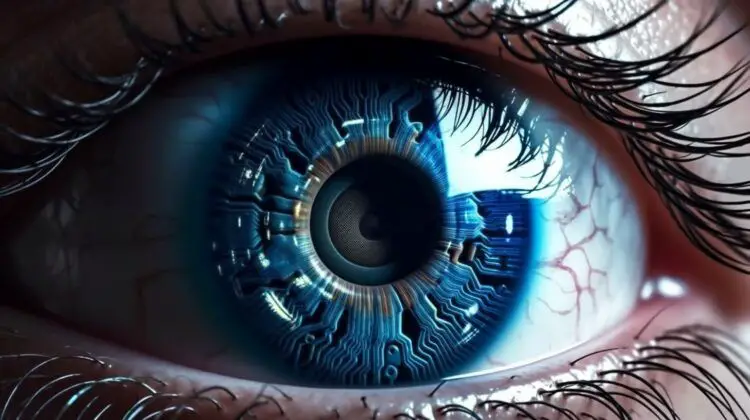The AI Eye is a revolutionary development arising at the biology and technology crossroads. This gadget, designed using the human eye as a model, utilizes AI to alter how we see the world. The AI Eye promises quicker and more efficient visuals. It can potentially transform industries as diverse as medical diagnostics and virtual reality.
This biomimetic device’s high-density array of nanowires, which mimics the human retina’s photoreceptors, might significantly advance robotics and visual prosthesis. The AI Eye has the potential to radically alter the technology environment due to its high image resolution and capacity to rebuild visual patterns.
The AI Eye—what is it?
The AI eye is a computerized device that can record, analyze, and decode visual data. Its design and operation are remarkably comparable to the human eye, with a lens focusing light onto a retina that sends electrical signals to the brain. It’s built to process visual data in a way that’s analogous to how our eyes do, but with many refinements that make it more efficient, accurate, and detail-aware. The artificial intelligence eye is an exciting new field of research made possible by painstaking engineering, cutting-edge algorithms, and neural networks.
Discovery: A new era in Visual Processing
The AI eye that the study team created should be seen as a remarkable scientific breakthrough because it reacts far more quickly than its organic version. This is because the AI eye can process visual information at a rate one hundred times quicker than its biological counterpart, allowing it to pick up on minute patterns and features that the human eye would otherwise miss. Unlike the human visual system, this allows it to process and understand visual information quickly.
However, the benefits of this technical advancement go far beyond mere velocity. The AI eye can potentially improve vision in ways human eyes cannot. The device’s sophisticated image recognition algorithms and neural networks enable it to pick up on nuances and complexities in visual data that would be missed by the naked eye. The consequences are far-reaching, touching on areas as diverse as medical diagnosis, surveillance technology, driverless cars, and virtual reality.

Delving deeper: The science of the AI eye
The “Electrochemical Eye” (EC-EYE) or AI eye, an artificial eye meant to resemble the human eye, is an engineering feat that should be taken seriously and replicated. To get a feel for the technology, let’s investigate a few of its salient characteristics:
- Front Side: The EC-EYE’s front features an iris-like diaphragm and a lens housed in an aluminum shell filled with an electrically charged liquid that simulates the vitreous system of the human eye.
- Back Side: In the rear, a silicon eye socket connects the sensors and their associated wiring, which then transmits electrical activity to a computer.
- Sensing Components: Sensing components comprise electrically sensitive nanowires with closer spacing than human photoreceptors. These nanowires respond to individual light particles even quicker than human photoreceptor cells.
EC-EYE is a major breakthrough in machine vision technology but raises new problems. Due to its curved design and the need for exact nanowire development and alignment, the EC-EYE may be more challenging to automate than conventional cameras. Other complications involve connecting the gadget to a computer for signal analysis.
Despite these limitations, EC-EYE has shown extremely promising early results. With further improvement, it can even outperform the human eye in image detection. The remarkable progress being made in the field of AI is demonstrated by this recent breakthrough. Furthermore, it provides hope for a future in which AI can be used to augment human eyesight.
See the scholarly publication from Harvard for a more in-depth analysis of this seminal study.

Possible effects and future vision of AI eye
Future surgeons could conduct difficult procedures/surgeries with pinpoint accuracy using the superior visual acuity of AI eyes. Or a world where security systems can swiftly and accurately identify potential dangers from vast volumes of visual data, owing to the AI eye. Simulations could become so lifelike that they would be impossible to tell apart from the actual world, and this would also impact the virtual reality area. It’s fascinating to think about what will happen when this work is combined with studies like Samsung’s research that imitates the human brain.
The artificially intelligent eye is in its earliest stages. While much work remains to be done, the advent of the AI eye is a significant step toward developing intelligent machinery with similar visual perception and understanding to humans. As researchers refine and improve upon this revolutionary technology, we might anticipate a future in which artificial intelligence (AI) enhances our vision, expanding the bounds of what we can see and comprehend.
Sources:
Harvard University Blog: “Looking to the Future: Creating an Artificial Eye”
Original Journal Article: “A biomimetic eye with a hemispherical perovskite nanowire array retina,” Nature
Image credits:
Featured image: Created via Midjourney by m.e.
New era of visual processing: Generated via Midjourney by m.e.
A Transhuman Perspective: A collage generated via Midjourney by m.e.





